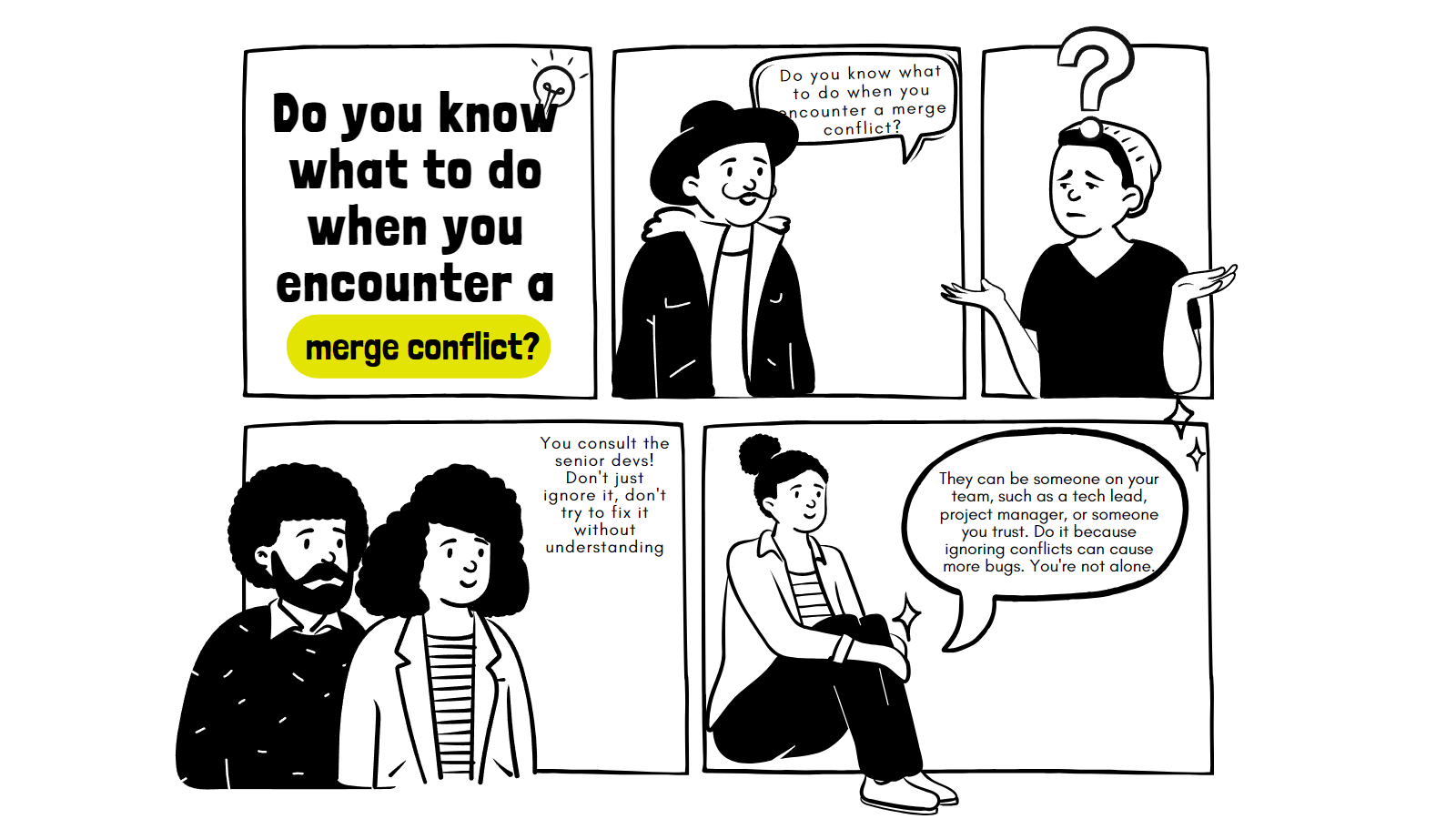How to Handle Merge Conflicts: A Developer's Stress-Free Guide
 Ajewole Seyi
Ajewole Seyi
Introduction
Ah, merge conflicts! The uninvited guests in our Git repositories. Whether you're a seasoned developer or just starting, you've probably encountered these pesky issues that seem to arise at the most inconvenient times. But fear not! In this guide, we'll break down everything you need to know about merge conflicts—what they are, how to handle them, and, most importantly, how to prevent them in the future.
What Are Merge Conflicts?
Imagine you're working on a group project. You and your friend both decide to edit the same paragraph in your shared document. When you go to merge your changes, you realize that your edits conflict with each other. Git merge conflicts are just like that but with code.
In simple terms, a merge conflict occurs when Git cannot automatically reconcile code differences between two branches. This usually happens when two people (or two separate commits) change the same line or nearby lines of code in a file.
Example Scenario
Let’s say you and your teammate are both working on a website project. You both pull the latest code from the main branch and create separate feature branches. You start working on feature/navbar while your teammate works on feature/footer.
# You create a new branch and start working on it
git checkout -b feature/navbar
# Meanwhile, your teammate creates their own branch
git checkout -b feature/footer
After some time, you both finish your features and decide to merge them back into the main branch. That’s when the drama begins.
Why Do Merge Conflicts Happen?
Merge conflicts usually occur in the following situations:
Same Line Conflict: When two branches modify the same line in a file.
Adjacent Line Conflict: When two branches modify adjacent lines in a file.
File Addition/Deletion*:* When one branch deletes a file that another branch modifies.
Unmerged Branch: When a branch that has conflicting changes is merged without resolving conflicts first.
A Quick Peek into a Merge Conflict
Here’s an example of what a merge conflict might look like in your code:
<div class="navbar">
<<<<<<< HEAD
<a href="/home">Home</a>
<a href="/about">About</a>
=======
<a href="/dashboard">Dashboard</a>
<a href="/profile">Profile</a>
>>>>>>> feature/navbar
</div>
This is Git’s way of saying, Hey, I don’t know which version you want to keep. Can you help me out?
The lines between
<<<<<<< HEADand=======represent the code from the current branch (e.g.,main).The lines between
=======and>>>>>>>represent the code from the branch being merged (e.g.,feature/navbar).
How to Resolve Merge Conflicts
Resolving merge conflicts might seem daunting, but with a little practice, it becomes second nature. Here’s a step-by-step guide:
Step 1: Identify the Conflict
When Git encounters a merge conflict, it pauses the merge process and marks the conflicted areas in the file. Your job is to decide which changes to keep.
# This command shows all files with merge conflicts
git status
Step 2: Open the Conflicted File
Open the file in your favorite code editor. You’ll see the conflict markers (<<<<<<<, =======, and >>>>>>>) indicating the conflicting sections.
Step 3: Choose Your Changes
Decide which changes to keep. You can:
Keep the current branch's changes: Remove the lines between
=======and>>>>>>>.Keep the incoming branch's changes: Remove the lines between
<<<<<<< HEADand=======.Combine both changes: Manually edit the file to include both sets of changes.
Here’s an example of combining changes:
<div class="navbar">
<a href="/home">Home</a>
<a href="/dashboard">Dashboard</a>
<a href="/about">About</a>
<a href="/profile">Profile</a>
</div>
Step 4: Mark as Resolved
After resolving the conflict, you need to tell Git that you’ve handled it.
# Stage the resolved files
git add <file>
# Continue the merge process
git commit
Step 5: Finish the Merge
If you have multiple conflicts, repeat the process for each file. Once all conflicts are resolved, Git will complete the merge.
Tips for Preventing Merge Conflicts
While merge conflicts are sometimes unavoidable, you can minimize their occurrence with some good practices:
Communicate with Your Team: Before starting work, check in with your teammates to see what they’re working on. This helps avoid overlapping changes.
Pull Changes Frequently: Regularly pull changes from the
mainbranch into your feature branch. This keeps your branch up-to-date and reduces the likelihood of conflicts.Keep Your Branches Short-Lived: Don’t let feature branches linger too long. The longer they exist, the more likely they are to diverge from
main.Use Feature Flags: If possible, use feature flags to integrate incomplete features into the
mainbranch without affecting production code.
Conclusion
Merge conflicts are an inevitable part of collaborative software development, but they don't have to be a source of stress. By understanding what causes them and following a systematic approach to resolving them, you can handle merge conflicts efficiently. Remember to communicate with your team, pull changes frequently, and keep your branches short-lived to minimize the chances of conflicts. With these practices in place, you'll find that managing merge conflicts becomes a routine part of your workflow, allowing you to focus more on writing great code and less on resolving conflicts. Happy coding!
Subscribe to my newsletter
Read articles from Ajewole Seyi directly inside your inbox. Subscribe to the newsletter, and don't miss out.
Written by

Ajewole Seyi
Ajewole Seyi
I am a highly skilled Frontend Developer with years of experience in designing and building responsive, user-centric web applications. My expertise lies in modern frontend technologies such as React, HTML, CSS, and JavaScript, with a strong focus on creating scalable and high-performance applications. I have a proven track record of collaborating with cross-functional teams to deliver solutions that enhance user experience and drive business goals. I am passionate about staying up-to-date with emerging technologies and applying innovative approaches to solve complex problems. My commitment to continuous learning and adaptability makes me a valuable asset to any forward-thinking team.